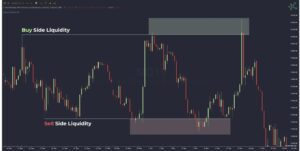ICT Trading Strategy: Best 5 intraday Trading Startegy

Introduction:
In the ever-evolving landscape of intraday option trading, traders are constantly seeking strategies that offer a competitive edge in the market. One such strategy that has garnered attention for its systematic approach and potential profitability is the ICT (Institutional Cluster Theory) strategy. In this comprehensive guide, we’ll explore what the ICT strategy entails, how it works, and how you can implement it effectively in your intraday option trading endeavors.
What is the ICT Trading Strategy?
The ICT strategy, also known as Institutional Cluster Theory, is a trading methodology that focuses on identifying clusters of institutional activity in the market. It operates under the premise that institutional traders, with their significant buying and selling power, leave distinct footprints in the market that can be observed and capitalized upon by astute traders.
How Does the ICT Trading Strategy Work?
At its core, the ICT strategy relies on the analysis of price action and volume to identify areas of accumulation and distribution by institutional players. By studying price movements in conjunction with volume spikes, traders can pinpoint areas where institutions are actively participating in the market, signaling potential opportunities for profitable trades.
Why Use the ICT Trading Strategy for Option Trading?
The ICT strategy offers several advantages for traders engaged in intraday option trading:
- Insight into Institutional Activity: By focusing on institutional activity, the ICT strategy provides traders with valuable insights into the market’s underlying dynamics. Understanding where institutions are buying and selling can help traders align their strategies with prevailing market sentiment.
- Identification of Key Levels: The ICT strategy helps traders identify key support and resistance levels based on institutional accumulation and distribution zones. These levels can serve as valuable reference points for making trading decisions, such as entry and exit points.
- Enhanced Risk Management: By identifying areas of institutional interest, traders can better manage their risk by placing stops and targets based on these key levels. This approach allows traders to minimize potential losses and maximize profits by trading in alignment with institutional flows.
- Confirmation of Trading Signals: The ICT strategy can be used as a confirmation tool alongside other technical indicators or trading methodologies. When price action aligns with institutional activity, it provides added confidence in the validity of trading signals.
Implementing the ICT Trading Strategy for Intraday Option Trading
Now, let’s delve into how you can apply the ICT strategy to intraday option trading:
1. Identifying Institutional Clusters:
Start by analyzing price charts and volume data to identify areas of significant price movement accompanied by high volume spikes. These clusters of activity often represent institutional involvement in the market and can serve as potential trade setups.
Example chart showing institutional clusters and option price movement.
2. Confirmation through Price Action:
Once you’ve identified potential institutional clusters, look for confirmation signals in the form of bullish or bearish price action patterns. These patterns can help validate the presence of institutional activity and provide additional confidence in your trading decisions.
3. Setting Risk Parameters:
Determine your risk tolerance and set appropriate stop-loss and target levels based on the identified institutional clusters. By aligning your risk parameters with key support and resistance levels, you can better manage your trades and optimize risk-reward ratios.
4. Trade Execution and Management:
Enter trades based on confirmed signals and manage them actively by monitoring price movements and adjusting your positions accordingly. Consider scaling into or out of trades as the market develops and institutional activity evolves.
5. Exit Strategy:
Exit trades based on predetermined criteria, such as reaching profit targets or encountering adverse market conditions. Additionally, closely monitor institutional activity and adjust your exit strategy if significant shifts occur in the market landscape.
Conclusion
The ICT strategy offers traders a systematic approach to intraday option trading by leveraging the insights derived from institutional activity in the market. By identifying clusters of institutional involvement and aligning trading decisions with prevailing market sentiment, traders can potentially enhance their profitability and achieve greater success in the dynamic world of intraday options.
As with any trading strategy, mastering the ICT strategy requires practice, discipline, and continuous refinement of skills. Utilize historical data and backtesting to validate the effectiveness of the strategy, and always remain adaptable to evolving market conditions. With dedication and perseverance, the ICT strategy can become a valuable tool in your trading arsenal, helping you navigate the complexities of intraday option trading with confidence and clarity.
To learn more about ICT Trading strategy click here



